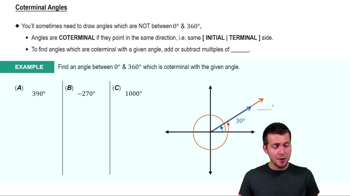Table of contents
- 0. Review of College Algebra4h 43m
- 1. Measuring Angles39m
- 2. Trigonometric Functions on Right Triangles2h 5m
- 3. Unit Circle1h 19m
- 4. Graphing Trigonometric Functions1h 19m
- 5. Inverse Trigonometric Functions and Basic Trigonometric Equations1h 41m
- 6. Trigonometric Identities and More Equations2h 34m
- 7. Non-Right Triangles1h 38m
- 8. Vectors2h 25m
- 9. Polar Equations2h 5m
- 10. Parametric Equations1h 6m
- 11. Graphing Complex Numbers1h 7m
1. Measuring Angles
Complementary and Supplementary Angles
Problem 14b
Textbook Question
Find the measure of each marked angle. In Exercises 19–22, m and n are parallel. See Examples 1 and 2 .
 Verified step by step guidance
Verified step by step guidance1
Identify the given angles and any relationships between them, such as corresponding angles, alternate interior angles, or alternate exterior angles, due to the parallel lines m and n.
Use the fact that corresponding angles are equal when two parallel lines are cut by a transversal to find the measure of the marked angles.
Apply the property that alternate interior angles are equal when two parallel lines are cut by a transversal to determine the measure of the marked angles.
If necessary, use the supplementary angle theorem, which states that angles on a straight line add up to 180 degrees, to find any remaining angle measures.
Verify your results by checking that all angle relationships and properties of parallel lines and transversals are satisfied.
Recommended similar problem, with video answer:
 Verified Solution
Verified SolutionThis video solution was recommended by our tutors as helpful for the problem above
Video duration:
4mPlay a video:
Was this helpful?
Key Concepts
Here are the essential concepts you must grasp in order to answer the question correctly.
Parallel Lines and Transversals
When two parallel lines are intersected by a transversal, several angle relationships are formed. Corresponding angles are equal, alternate interior angles are equal, and consecutive interior angles are supplementary. Understanding these relationships is crucial for finding unknown angle measures in geometric problems involving parallel lines.
Recommended video:

Example 1
Angle Relationships
In geometry, angles can be classified into various relationships such as complementary, supplementary, and vertical angles. Complementary angles sum to 90 degrees, while supplementary angles sum to 180 degrees. Recognizing these relationships helps in solving for unknown angles when given certain angle measures.
Recommended video:

Coterminal Angles
Angle Notation and Measurement
Angles are often denoted using symbols such as m∠A to represent the measure of angle A. Understanding how to interpret angle notation and measure angles in degrees is essential for solving problems in trigonometry and geometry. This includes knowing how to apply the correct units and notation when calculating or expressing angle measures.
Recommended video:

i & j Notation

 3:35m
3:35mWatch next
Master Intro to Complementary & Supplementary Angles with a bite sized video explanation from Patrick Ford
Start learningRelated Videos
Related Practice








